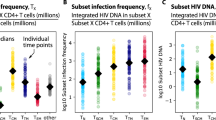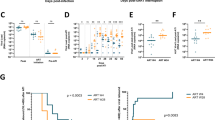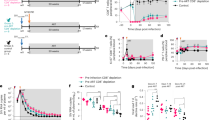Abstract
The origin of CD4+ T cells reappearing in the blood following antiretroviral therapy in human immunodeficiency virus type-1 (HIV-1) infection is still controversial. Here we show, using mathematical modeling, that redistribution of T cells to the blood can explain the striking correlation between the initial CD4+ and CD8+ memory T-cell repopulation and the observation that 3 weeks after the start of treatment memory CD4+ T-cell numbers reach a plateau. The increase in CD4+ T cells following therapy most likely is a composite of initial redistribution, accompanied by a continuous slow repopulation with newly produced naive T cells.
This is a preview of subscription content, access via your institution
Access options
Subscribe to this journal
Receive 12 print issues and online access
$209.00 per year
only $17.42 per issue
Buy this article
- Purchase on Springer Link
- Instant access to full article PDF
Prices may be subject to local taxes which are calculated during checkout
Similar content being viewed by others
References
Cavert, W. et al. Kinetics of response in lymphoid tissues to antiretroviral therapy of HIV-1 infection. Science 276, 960–964 (1997).
Lafeuillade, A., Poggi, C., Profizi, N., Tamalet, C. . & Costes, O. Human immunodeficiency virus type 1 kinetics in lymph nodes compared with plasma. J. Infect. Dis. 174, 404–407 (1996).
Perelson, A.S. et al. Decay characteristics of HIV-1 infected compartments during combination therapy. Nature 387, 188–191 (1997).
Notermans, D.W. et al. Decrease of HIV-1 RNA levels in lymphoid tissue and peripheral blood during treatment with ritonavir, lamivudine and zidovudine. AIDS (in the press).
Wei, X. et al. Viral dynamics in human immunodeficiency virus typei infection. Nature 373, 117–122 (1995).
Ho, D.D. et al. lymphocytes in HIV-1 infection. Nature 373, 123–126 (1995).
Kelleher, A.D., Carr, A., Zaunders, J. & Cooper, D.A. Alterations in the immune response of human immunodeficiency virus (HIV) infected subjects treated with an HIV-specific protease inhibitor, ritonavir. J. Infect. Dis. 173, 321–329 (1996).
Picker, L.J. et al. Control of lymphocyte recirculation in man: Differential regulation of the peripheral lymph node homing receptor L-selectin on T cells during the virgin to memory cell transition. J.Immunol. 150 1105–1121 (1993)
Roederer, M. et al. CD8 naive T cell counts decrease progressively in HIV infected adults. J. Clin. Invest 95, 2061–2066 (1995).
Perelson, A.S., Neumann, A.U., Markowitz, M., Leonard, J.M. & Ho, D.D. HIV-1 dynamics in vivo: Virion clearance rate, infected cell life-span, and viral generation time. Science 271, 1582–1586 (1996).
Tough, D.F. & Sprent, J. Viruses and T cell turnover: Evidence for bystander proliferation. Immunol. Rev. 150,129–142 (1996).
Ahmed, R. & Gray, D. Immunological memory and protective immunity: Understanding their relation. Science 272,54–60 (1996).
Mosier, D.E., Sprent, J., Tough, D., Dimitrov, D.S. & Martin, M.A. HIV results in the frame: CD4+ cell turnover (letter). Nature 375, 193–195 (1995).
Phillips, A.N., Sabin, C.A., Mocroft, A. & janossy, C. HIV results in the frame: Antiviral therapy (letter). Nature 375, 195 (1995).
Westermann, J. & Pabst, R. Lymphocyte subsets in the blood: A diagnostic window on the lymphoid system? Immunol. Today 11, 406 (1990).
Butcher, E.C. & Picker, L.J. Lymphocyte homing and homeostasis. Science 272, 60–66(1996).
Pantaleo, G. et al. HIV infection is active and progressive in lymphoid tissue during the clinically latent stage of disease. Nature 362, 355–358 (1993).
Giorgi, J.V. Phenotype and function of T cells in HIV disease, in Immunology of HIV Infection. (ed. Gupta, S.) 181–199 (Plenum Press, New York, 1996).
Wang, L., Robb, C.W. & Cloyd, M.W. HIV induces homing of resting T lymphocytes to lymph nodes.Virology 228, 141–152 (1997).
Gray, D. Immunological memory. Annu. Rev. Immunol. 11, 49–77 (1993).
Zhang, Z. et al. Naive CD4+ T cells repopulate lymphoid tissues after treatment of HIV-1 infection. Proc. Natl. Acad. Sci USA (in the press).
Connors, M. et al. Infection induces changes in CD4+ T-cell phenotype and depletions within the CD4+ T-cell repertoire that are not immediately restored by antiviral or immune-based therapies. Nature Med. 3, 533–540 (1997).
Wolthers, K.C. et al. T-cell telomore length infection: No evidence for increased CD4+ T cell turnover. Science 274, 1543–1547 (1996).
Pommier, J.-P. et al. Immunosenescence in HIV pathogenesis. Virology 231, 148–154(1997).
Palmer, L.D. et al. Telomere length, telomerase activity, and replicative potential in HIV infection: Analysis of CD4+ and CD8+ T cells from HIV-discordant monozy-gotic twins. J. Exp. Med. 185, 1381–1386 (1997).
Paganin, C., Monos, D.S., Marshall, J.D., Frank, I., & Trinchieri, G. Frequency and cytokine profile of HPRT mutant T cells in HIV-infected and healthy donors: Implications for T cell proliferation in HIV disease J. Clin. Invest. 99, 663–667 (1997).
Mackall, C.L. et al. Age, thymopoiesis, and CD4+ T-lymphocyte regeneration after intensive chemotherapy. N. Engl. J. Med. 332, 143–149 (1995).
Ottinger, H.D., Beelen, D.W., Scheulen, B., Schaefer, U.W. & Gross-Wilde, H. Improved immune reconstitution after allotransplantation of peripheral blood stem cells instead of bone marrow. Blood 88, 2775–2779 (1996).
Rep, M. et al. Treatment with depleting CD4 monoclonal antibody results in a preferential loss of circulating naive T cells but does not affect IFN-τ secreting TH1 cells in humans. J. Clin. Invest. 99, 2225–2231 (1997).
Weng, N.-P., Levine, B.L., June, C.H. & Hodes, R.J. Human naive and memory T lymphocytes differ in telomeric length and replicative potential. Proc. Natl. Acad. Sci. USA 92,11091–11094 (1995).
Autran, B. et al. 4+ T cell homeostasis and function in advanced HIV disease. Science 277 112–116 (1997).
Hammer, S.M. et al. A trial comparing nucleoside monotherapy with combination therapy in HIV-infected adults with CD4 cell counts from 200 to 500 per cubic millimeter. N. Engl. J. Med. 335,1081 1090 (1996).
Katzenstein, D.A. et al. The relation of virologic and immunologic markers to clinical outcomes after nucleoside therapy in HIV-infected adults with 200 to 500 CD4 cells per cubic millimeter. N. Engl. J. Med. 335, 1091–1098 (1996).
Delta coordinating committee. Delta: A randomised double-blind controlled trial comparing combinations of zidovudine plus didanosine or zalcitabine with zidovudine alone in HIV-infected individuals. Lancet 348, 283–291 (1996).
O'Brien, W.A. et al. Changes in plasma HIV RNA levels and CD4+ lymphocyte counts predict both response to antiretroviral therapy and therapeutic failure. Ann. Intern. Med. 126, 939–945 (1997).
Roos, M.T.L. et al. T-cell function in vitro is an independent progression marker for AIDS in human immunodeficiency virus (HIV)-infected asymptomatic individuals. J. Infect. Dis. 171, 531–536 (1995).
Koot, M. et al. Viral phenotype and T-cell reactivity in human immunodeficiency virus type 1 -infected asymptomatic men treated with zidovudine. J. Infect. Dis. 168,733–736(1993).
Bindels, P.J.E. et al. The predictive value of T cell function in vitro and pre AIDS zidovudine use for survival after AIDS diagnosis in a cohort of homosexual men in Amsterdam. J. Infect. Dis. 172, 97–104 (1995).
Pakker, N.G. et al. Patterns of T cell repopulation, viral load reduction and restoration of T cell function in human immunodeficiency virus infected persons during therapy with different antiretrovirals. J. Acquire. Immune Defic. Syndr. Hum. Retrovirol. 16, 318–326 (1997).
Bloemena, E., Roos, M.T.L., van Heijst, J.L.A.M., Vossen, J.M.J.j. & Schellekens, P.T.A. Whole-blood lymphocyte cultures. J. Immunol. Methods 122, 161–167 (1989).
1993 revised classification system for HIV infection and expanded surveillance case definition for AIDS among adolescents and adults. MMWR Morbid. Mortal. Wkly. Rep. 41, 1 (1992).
Author information
Authors and Affiliations
Corresponding author
Rights and permissions
About this article
Cite this article
Pakker, N., Notermans, D., De Boer, R. et al. Biphasic kinetics of peripheral blood T cells after triple combination therapy in HIV-1 infection: A composite of redistribution and proliferation. Nat Med 4, 208–214 (1998). https://doi.org/10.1038/nm0298-208
Received:
Accepted:
Issue Date:
DOI: https://doi.org/10.1038/nm0298-208
This article is cited by
-
Plasma anti-CD4 IgG is associated with brain abnormalities in people with HIV on antiretroviral therapy
Journal of NeuroVirology (2021)
-
Hypervitaminosis A is associated with immunological non-response in HIV-1-infected adults: a case-control study
European Journal of Clinical Microbiology & Infectious Diseases (2020)
-
Enhanced IFN-γ, but not IL-2, response to Mycobacterium tuberculosis antigens in HIV/latent TB co-infected patients on long-term HAART
BMC Immunology (2019)
-
HIV-associated opsoclonus-myoclonus-ataxia syndrome: early infection, immune reconstitution syndrome or secondary to other diseases? Case report and literature review
Journal of NeuroVirology (2018)
-
Pattern and predictors of immunologic recovery in HIV infected patients
BMC Research Notes (2015)



